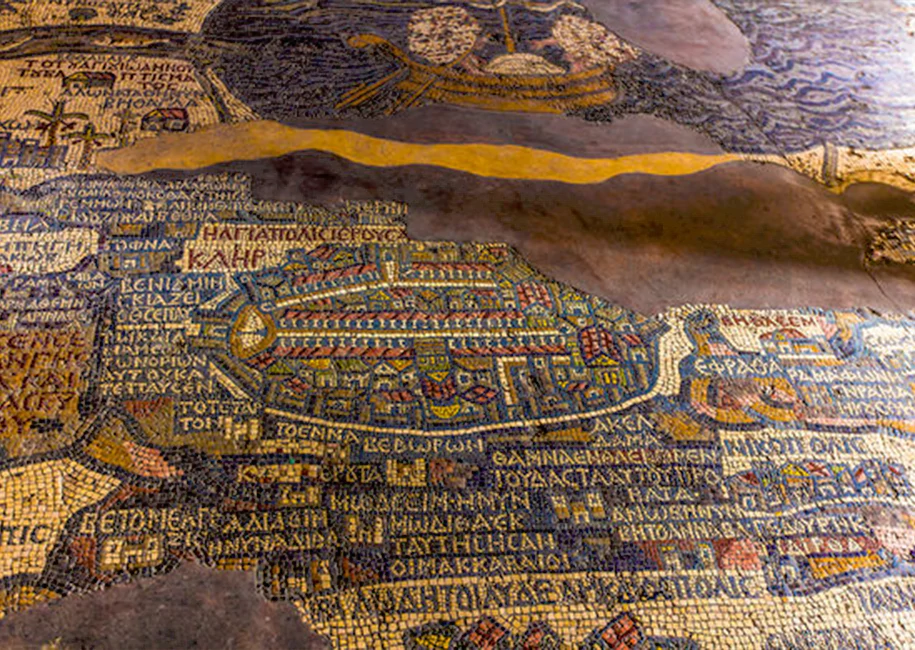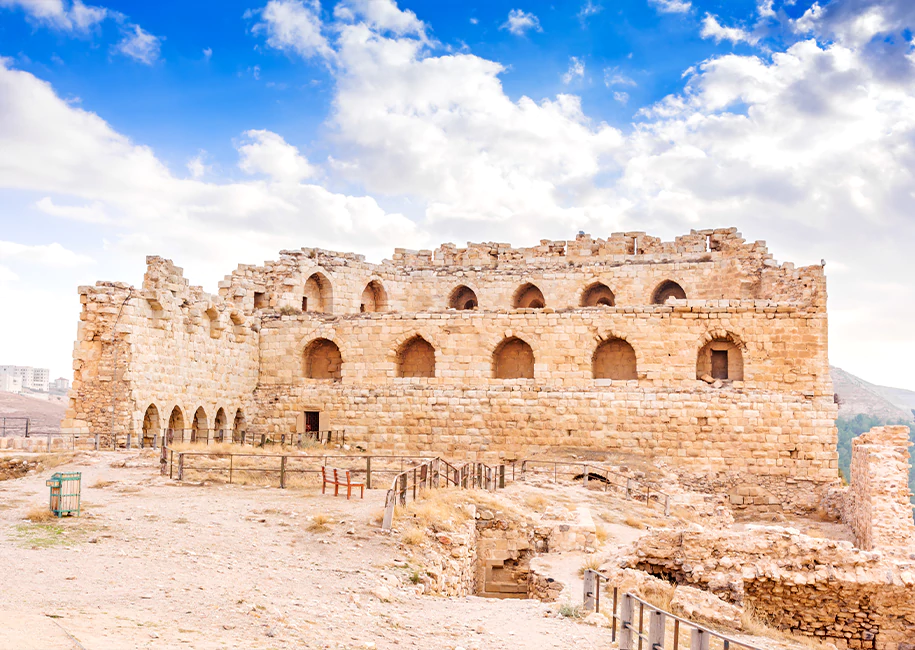
Attractions through the King’s Highway
The Kings' Highway runs down the spine of Jordan's central highlands and different ecological zones of the country, including forested highlands, open farmland plateaus, deep ravines, the edge of the eastern desert, and the warm tropical Gulf of Aqaba. Lining both sides of this 335 kilometer (208 miles) thoroughfare is a rich chain of archaeological sites that reads like an index of ancient history and a biblical gazetteer -- prehistoric villages from the Stone Age, biblical towns from the Kingdoms of Ammon, Moab and Edom, Crusader Castles, some of the finest early Christian Byzantine mosaics in the Middle East, a Roman-Herodian fortress, several Nabataean temples, two major Roman fortresses, early Islamic towns, and the rock-cut Nabataean capital of Petra.
Here are the major destination that must visit when taking this ancient highway.
MT. NEBO

Is a 1,000m (3,300ft) high mountain located 10km/6 mi NW of Madaba in Jordan, opposite the northern end of the Dead Sea. According to ancient tradition, this is the mountain from which Moses saw the Promised Land before he died. Because of its connection to Moses, Mt. Nebo has long been an important place of Christian pilgrimage. Excavations led by the Franciscans, who own the site, have uncovered significant remains of the early church and its magnificent Byzantine mosaics. A simple modern shelter dedicated to Moses has been built over them.
The site was abandoned by 1564 and remained mostly neglected for several centuries more. Finally, in 1993, the site was purchased by the Franciscans, who excavated and restored the area. On March 19, 2000, Pope John Paul II visited the site during his pilgrimage to the Holy Land, planting an olive tree next to the Byzantine chapel for peace.
MADABA

Best known for its spectacular Byzantine and Umayyad mosaics, Madaba is home to the famous 6th century Mosaic Map of Jerusalem and the Holy Land. With two million pieces of vividly coloured local stone, it depicts hills and valleys, villages and towns as far as the Nile Delta. The Madaba Mosaic Map covers the floor of the Greek Orthodox Church of St. George, which is located northwest of the city centre. The church was built in 1896 AD, over the remains of a much earlier 6th century Byzantine church. The mosaic panel enclosing the Map was originally around 15.6 X 6m, 94 sq. m., only about a quarter of which is preserved. Other mosaic masterpieces found in the Church of the Virgin and the Apostles and in the Archaeological Museum depict a rampant profusion of flowers and plants, birds and fish, animals and exotic beasts, as well as scenes from mythology and the everyday pursuits of hunting, fishing and farming. Literally, hundreds of other mosaics from the 5th through the 7th centuries are scattered throughout Madaba's churches and homes. In line with Jordan's commitment to restoring and preserving its mosaic masterpieces, Madaba’s extensive Archaeological Park and Museum complex encompasses the remains of several Byzantine churches, including the outstanding mosaics of the Church of the Virgin and the Hyppolytus Hall, part of a 6th century mansion.
WADI AL MUJIB

Wadi al-Mujib is the lowest nature reserve in the world, reaching the highest level in 900 meter, the lowest in 400 meter below sea level. The area about 220 square km offers a variety in nature and wildlife and is a hotspot for eco- and adventure tourism. The UNESCO declared Mujib in 2011 as biosphere reserve. Wadi Mujib, the biblical Arnon River, is also called the Grand Canyon of Jordan. Over 300 species of plants, 10 species of carnivores and numerous species of permanent and migratory birds have been recorded. Some of the Remote Mountain and valley areas are difficult to reach, and thus offer safe havens for rare species of cats, goats and other mountain animals. Mujib's sandstone cliffs are an ideal habitat for one of the most beautiful mountain goats in the world, the horned Ibex, also for the caracal, a medium sized cat.
DANA RESERVE

Dana is Jordan’s largest nature reserve, covering some 320 square kilometers of spectacular mountains and Wadis along the face of the Great Rift Valley. From scorching sand dunes in the west to cool mountaintops in the east, the Dana Biosphere Reserve is home to a great variety of wildlife. There are plants and animals characteristic of true desert, of Mediterranean forests and of the dry plains of Russia. In fact, Dana is really a melting pot of species from three continents: Europe, Africa and Asia. Such a combination of natural communities in a single area is unique in Jordan and many of Dana’s animals and plants are very rare. So far, a total of 700 plant species, 190 bird species, 37 mammal species and 36 reptile species have been recorded in the Reserve, of which 25 are known to be endangered, including the Sand Cat, the Syrian Wolf, the Lesser Kestrel and the Spiny Tailed Lizard. Without special care, some of these could disappear from Earth forever, which makes the Dana Biosphere Reserve a place of global importance.
KERAK CASTLE

The most visitors come to see the Crusader castle on the hilltop. The fortress was built in the 12th century and ruled by Payen le Bouteiller, the Lord of Transjordan (Oultrejordain). Karak had been a fortress since biblical times, the King of Israel and his allies from Judah and Edom besieged here the Moabite king Mesha. What to see today is mainly from Crusader times, as its strategic position enabled to control Bedouin herders as well as trade routes from Damascus to Egypt and Mecca. Karak's most famous because brutal occupant was Reynald de Chatillon, who came in power in 1176. Breaking all treaties, he began to raid caravans and even threatened Mecca. As response Sultan Salah ad Din, the ruler of Syria and Egypt, attacked the castle and finally captured it in 1189. Karak became the capital of a district covering much of Jordan, playing a central role in Middle Eastern politics for the next two centuries. It was the capital of the whole Mameluk kingdom when Sultan an-Nasir Ahmad grew weary of power struggles in Cairo. His brother and successor Salih Ismail took the fortress and returned the royal insignia. During these sieges Karak was the first target of modern artillery in the Middle East, Salih Ismail used cannons and gunpowder. During the Ottoman rule, the Mameluk palace inside the castle was used as a prison.
SHOBAK CASTLE

Set atop a mountain, Shobak Castle was originally called Krak de Montreal or Mons Regalis and an enchanting castle that was built in 1115 under the rule of King Baldwin I. Shobak Castle is particularly striking due to its remote location in the desert which will make visitors feel a world away from home. It is perched on the side of a rocky, conical mountain at 1,300m (4,265ft) above sea level, looking out over fruit trees below. Within the castle grounds, visitors can explore the churches, historic ruins, and a secret passageway that leads to a charming spring. The castle also boasts a watchtower, catacombs and a number of Christian carvings and Islamic tablets.